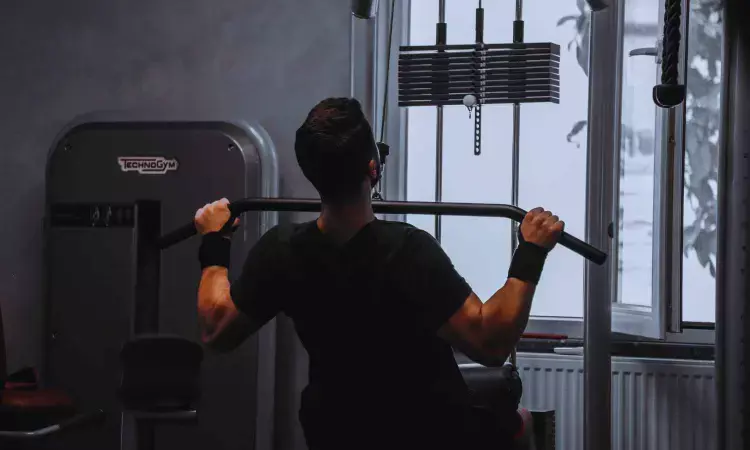- Home
- Medical news & Guidelines
- Anesthesiology
- Cardiology and CTVS
- Critical Care
- Dentistry
- Dermatology
- Diabetes and Endocrinology
- ENT
- Gastroenterology
- Medicine
- Nephrology
- Neurology
- Obstretics-Gynaecology
- Oncology
- Ophthalmology
- Orthopaedics
- Pediatrics-Neonatology
- Psychiatry
- Pulmonology
- Radiology
- Surgery
- Urology
- Laboratory Medicine
- Diet
- Nursing
- Paramedical
- Physiotherapy
- Health news
- Fact Check
- Bone Health Fact Check
- Brain Health Fact Check
- Cancer Related Fact Check
- Child Care Fact Check
- Dental and oral health fact check
- Diabetes and metabolic health fact check
- Diet and Nutrition Fact Check
- Eye and ENT Care Fact Check
- Fitness fact check
- Gut health fact check
- Heart health fact check
- Kidney health fact check
- Medical education fact check
- Men's health fact check
- Respiratory fact check
- Skin and hair care fact check
- Vaccine and Immunization fact check
- Women's health fact check
- AYUSH
- State News
- Andaman and Nicobar Islands
- Andhra Pradesh
- Arunachal Pradesh
- Assam
- Bihar
- Chandigarh
- Chattisgarh
- Dadra and Nagar Haveli
- Daman and Diu
- Delhi
- Goa
- Gujarat
- Haryana
- Himachal Pradesh
- Jammu & Kashmir
- Jharkhand
- Karnataka
- Kerala
- Ladakh
- Lakshadweep
- Madhya Pradesh
- Maharashtra
- Manipur
- Meghalaya
- Mizoram
- Nagaland
- Odisha
- Puducherry
- Punjab
- Rajasthan
- Sikkim
- Tamil Nadu
- Telangana
- Tripura
- Uttar Pradesh
- Uttrakhand
- West Bengal
- Medical Education
- Industry
Minimal-Equipment Pulmonary Rehab Matches Benefits of Full Gym Setup: JAMA

A new study published in the Journal of American Medical Association showed that pulmonary rehabilitation with minimal equipment was as effective as programs using treadmills and specialty gym gear, with similar improvements in dyspnea and quality of life lasting up to one year, potentially increasing accessibility for home or community settings.
People with chronic respiratory diseases benefit from pulmonary rehabilitation (PR) in terms of exercise tolerance, symptom load, and health-related quality of life. But there is a greater need for PR than there is supply.
PR has always been administered with specialized, gym-based workout equipment. This study examined the potential non-inferiority of PR utilizing specialized gym workout equipment (PR-gym) vs PR using minimum equipment (PR-min).
PR-min and PR-gym were compared in this parallel, two-group, noninferiority randomized clinical study that was blinded by assessors and statisticians. People with chronic respiratory conditions who were referred for PR to the Regional Pulmonary Rehabilitation Unit in northwest London, UK, were eligible to participate. Between October 15, 2018, and December 21, 2021, recruitment was place, with a final follow-up scheduled on December 14, 2022.
An separate web-based method that used minimization and 1:1 allocation was used for randomization. The period of data analysis was May 2023–January 2025. For 8 weeks, all PR programs included 2 in-person, outpatient supervised sessions per week. While PR-gym utilized specialized workout equipment (such as treadmills and weight machines), PR-min used less equipment (such as walking circuits and body weight exercises).
With 218 randomly assigned to PR-min and 218 to PR-gym, a total of 436 individuals (median [IQR] age, 71.7 [63.2-77.7] years; 239 [54.8%] male) were included.
ISW distance was significantly improved at 8 weeks by PR-min (n = 136) and PR-gym (n = 130), with no significant difference between groups (mean, 1.7 m; 1-sided 97.5% CI lower limit, −16.8), falling within the −24-m noninferiority margin.
A comprehensive set of sensitivity analyses and the intention-to-treat analysis showed that PR-min was not inferior than PR-gym.
Comparable results were seen for health-related quality of life and dyspnea. Also, the intervention did not result in any excessive negative occurrences or expenses.
Overall, PR-min was linked to improvements in exercise capacity and health-related quality of life that were comparable to those linked to PR-gym. This noninferiority lasted for a whole year without incurring any extra expenses.
Source:
Nolan, C. M., Glen, C., Walsh, J. A., Patel, S., Barker, R. E., Polgar, O., Spain, N., Littlemore, H., Jung, P., Edwards, G. D., Jenkins, T. O., Harvey, J., Ingram, K., Newby, C., Steiner, M., Wilson, R., Gao, W., Fiorentino, F., Chukwusa, E., … Man, W. D. C. (2025). Minimal vs specialized exercise equipment for pulmonary rehabilitation: A randomized clinical trial. JAMA Network Open, 8(8), e2526616. https://doi.org/10.1001/jamanetworkopen.2025.26616
Neuroscience Masters graduate
Jacinthlyn Sylvia, a Neuroscience Master's graduate from Chennai has worked extensively in deciphering the neurobiology of cognition and motor control in aging. She also has spread-out exposure to Neurosurgery from her Bachelor’s. She is currently involved in active Neuro-Oncology research. She is an upcoming neuroscientist with a fiery passion for writing. Her news cover at Medical Dialogues feature recent discoveries and updates from the healthcare and biomedical research fields. She can be reached at editorial@medicaldialogues.in
Dr Kamal Kant Kohli-MBBS, DTCD- a chest specialist with more than 30 years of practice and a flair for writing clinical articles, Dr Kamal Kant Kohli joined Medical Dialogues as a Chief Editor of Medical News. Besides writing articles, as an editor, he proofreads and verifies all the medical content published on Medical Dialogues including those coming from journals, studies,medical conferences,guidelines etc. Email: drkohli@medicaldialogues.in. Contact no. 011-43720751


